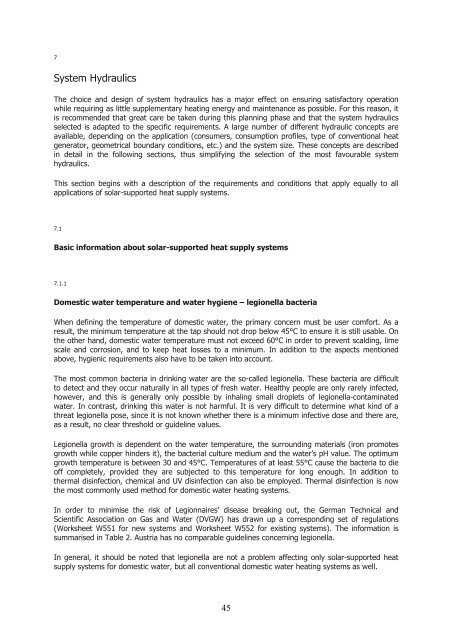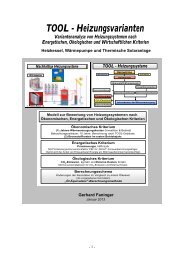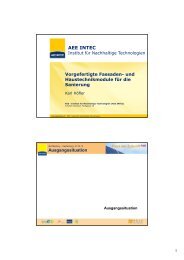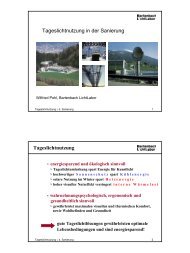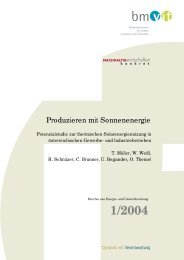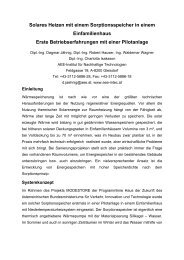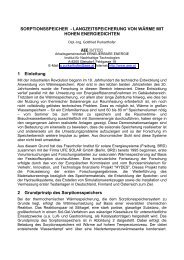Solar-supported heating networks in multi-storey residential buildings
Solar-supported heating networks in multi-storey residential buildings
Solar-supported heating networks in multi-storey residential buildings
Create successful ePaper yourself
Turn your PDF publications into a flip-book with our unique Google optimized e-Paper software.
7<br />
System Hydraulics<br />
The choice and design of system hydraulics has a major effect on ensur<strong>in</strong>g satisfactory operation<br />
while requir<strong>in</strong>g as little supplementary <strong>heat<strong>in</strong>g</strong> energy and ma<strong>in</strong>tenance as possible. For this reason, it<br />
is recommended that great care be taken dur<strong>in</strong>g this plann<strong>in</strong>g phase and that the system hydraulics<br />
selected is adapted to the specific requirements. A large number of different hydraulic concepts are<br />
available, depend<strong>in</strong>g on the application (consumers, consumption profiles, type of conventional heat<br />
generator, geometrical boundary conditions, etc.) and the system size. These concepts are described<br />
<strong>in</strong> detail <strong>in</strong> the follow<strong>in</strong>g sections, thus simplify<strong>in</strong>g the selection of the most favourable system<br />
hydraulics.<br />
This section beg<strong>in</strong>s with a description of the requirements and conditions that apply equally to all<br />
applications of solar-<strong>supported</strong> heat supply systems.<br />
7.1<br />
Basic <strong>in</strong>formation about solar-<strong>supported</strong> heat supply systems<br />
7.1.1<br />
Domestic water temperature and water hygiene – legionella bacteria<br />
When def<strong>in</strong><strong>in</strong>g the temperature of domestic water, the primary concern must be user comfort. As a<br />
result, the m<strong>in</strong>imum temperature at the tap should not drop below 45°C to ensure it is still usable. On<br />
the other hand, domestic water temperature must not exceed 60°C <strong>in</strong> order to prevent scald<strong>in</strong>g, lime<br />
scale and corrosion, and to keep heat losses to a m<strong>in</strong>imum. In addition to the aspects mentioned<br />
above, hygienic requirements also have to be taken <strong>in</strong>to account.<br />
The most common bacteria <strong>in</strong> dr<strong>in</strong>k<strong>in</strong>g water are the so-called legionella. These bacteria are difficult<br />
to detect and they occur naturally <strong>in</strong> all types of fresh water. Healthy people are only rarely <strong>in</strong>fected,<br />
however, and this is generally only possible by <strong>in</strong>hal<strong>in</strong>g small droplets of legionella-contam<strong>in</strong>ated<br />
water. In contrast, dr<strong>in</strong>k<strong>in</strong>g this water is not harmful. It is very difficult to determ<strong>in</strong>e what k<strong>in</strong>d of a<br />
threat legionella pose, s<strong>in</strong>ce it is not known whether there is a m<strong>in</strong>imum <strong>in</strong>fective dose and there are,<br />
as a result, no clear threshold or guidel<strong>in</strong>e values.<br />
Legionella growth is dependent on the water temperature, the surround<strong>in</strong>g materials (iron promotes<br />
growth while copper h<strong>in</strong>ders it), the bacterial culture medium and the water’s pH value. The optimum<br />
growth temperature is between 30 and 45°C. Temperatures of at least 55°C cause the bacteria to die<br />
off completely, provided they are subjected to this temperature for long enough. In addition to<br />
thermal dis<strong>in</strong>fection, chemical and UV dis<strong>in</strong>fection can also be employed. Thermal dis<strong>in</strong>fection is now<br />
the most commonly used method for domestic water <strong>heat<strong>in</strong>g</strong> systems.<br />
In order to m<strong>in</strong>imise the risk of Legionnaires’ disease break<strong>in</strong>g out, the German Technical and<br />
Scientific Association on Gas and Water (DVGW) has drawn up a correspond<strong>in</strong>g set of regulations<br />
(Worksheet W551 for new systems and Worksheet W552 for exist<strong>in</strong>g systems). The <strong>in</strong>formation is<br />
summarised <strong>in</strong> Table 2. Austria has no comparable guidel<strong>in</strong>es concern<strong>in</strong>g legionella.<br />
In general, it should be noted that legionella are not a problem affect<strong>in</strong>g only solar-<strong>supported</strong> heat<br />
supply systems for domestic water, but all conventional domestic water <strong>heat<strong>in</strong>g</strong> systems as well.<br />
45


